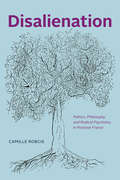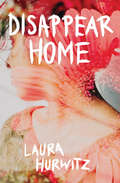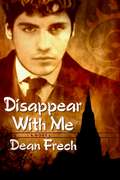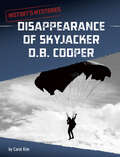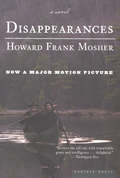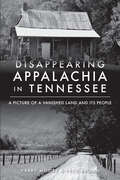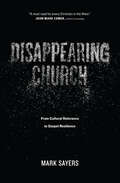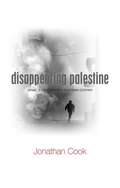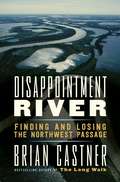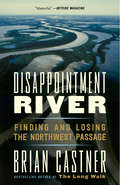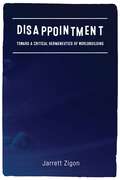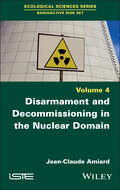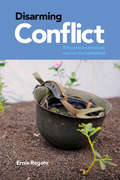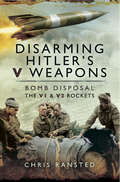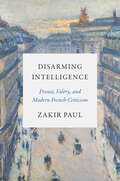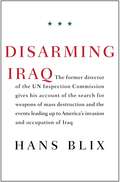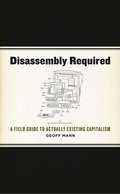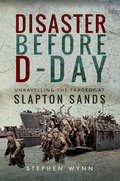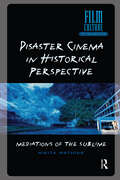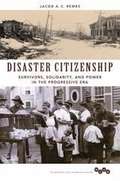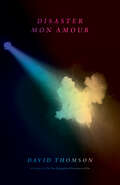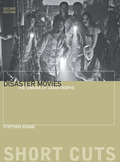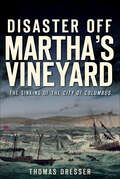- Table View
- List View
Disalienation: Politics, Philosophy, and Radical Psychiatry in Postwar France (Chicago Studies In Practices Of Meaning Ser.)
by Camille RobcisFrom 1940 to 1945, forty thousand patients died in French psychiatric hospitals. The Vichy regime’s “soft extermination” let patients die of cold, starvation, or lack of care. But in Saint-Alban-sur-Limagnole, a small village in central France, one psychiatric hospital attempted to resist. Hoarding food with the help of the local population, the staff not only worked to keep patients alive but began to rethink the practical and theoretical bases of psychiatric care. The movement that began at Saint-Alban came to be known as institutional psychotherapy and would go on to have a profound influence on postwar French thought. In Disalienation, Camille Robcis grapples with the historical, intellectual, and psychiatric meaning of the ethics articulated at Saint-Alban by exploring the movement’s key thinkers, including François Tosquelles, Frantz Fanon, Félix Guattari, and Michel Foucault. Anchored in the history of one hospital, Robcis's study draws on a wide geographic context—revolutionary Spain, occupied France, colonial Algeria, and beyond—and charts the movement's place within a broad political-economic landscape, from fascism to Stalinism to postwar capitalism.
Disappear Home
by Laura HurwitzIn 1970, as the hippie movement is losing its innocence, Shoshanna and her six-year-old sister, Mara, escape from Sweet Earth Farm, a declining commune, run by their tyrannical and abusive father, Adam. Their mother, Ella, takes them to San Francisco, where they meet one of her old friends, Judy, and the four of them decide to head off and try to make a life together. Finding a safe haven at the farm of kind, elderly Avery Elliot, the four of them find some measure of peace and stability. Then their mother's crippling depression returns. Confused and paranoid, Ella is convinced that she and the girls must leave before Adam finds them and exacts revenge. The girls don't wish to leave the only stable home they've ever had. But as Ella grows worse and worse, events conspire to leave them to face a choice they never could have imagined. Shoshanna has always watched over her sister and once again she has to watch over her ailing mother. Will she ever live a "normal" life?
Disappear with Me
by Dean FrechIn 1910, the United Kingdom is in turmoil. King Edward dies after only nine years on the throne. The social class system that upheld British society for centuries is being chipped away by social, political, and economic unrest across the Empire. Amidst this backdrop, Reverend Leander Norris is accused of sodomy. After discovering his own self-worth and the meaning of unconditional love, Leander finds the courage to stand up for what he believes is right and pleads "not guilty" to the charges.Throughout the trial, Leander's past is revealed, including the temptations that bring the accusations against him. By the end of the trial, Leander is once again reunited with a romantic interest from the past. But it may be too late to rekindle any love that remains, given the circumstances of the era and Leander's likely sentence.Love is greater than hope or faith, but can Leander convince a jury that the love he shares with another man is natural?
Disappearance of Skyjacker D. B. Cooper (History's Mysteries)
by Carol KimOn November 24, 1971, a man boarded a passenger plane in Portland, Oregon. Later, he would become known as D. B. Cooper. But that wasn’t his real name, and he was no ordinary passenger. He hijacked the plane, demanded $200,000, and parachuted out of the plane with the money. He was never seen again. Who was D. B. Cooper, and what happened to him? Explore the theories behind this crime and why it has become one of history’s greatest mysteries.
Disappearances: A Novel (Center Point Premier Fiction (large Print) Ser.)
by Howard Frank MosherNew England Book Award Winner: A father and son smuggle liquor across the border in Depression-era Vermont in this &“remarkable and wonderful&” novel (The Christian Science Monitor).This endearing novel is both a heroic adventure and a thrilling coming-of-age story. It is the memorable tale of a young man named Wild Bill Bonhomme, his larger-than-life father, Quebec Bill, and their whiskey-smuggling exploits along the Vermont-Canada border in 1932. On an epic journey through the wilderness, Bill and his father encounter a cast of wild characters—and live out magical escapades as they carve their way into legend.&“Revives the tall tale with remarkable grace and intelligence…delightful.&”—The Washington Post&“Disappearances at its best is reminiscent of manic Faulkner, wild and violent and violently funny.&”—The Boston Herald &“Rollicking, boisterous, sprawling, [and] highly entertaining.&”—Harper&’s Magazine
Disappearing Acts: Spectacles of Gender and Nationalism in Argentina’s “Dirty War”
by Diana TaylorIn Disappearing Acts, Diana Taylor looks at how national identity is shaped, gendered, and contested through spectacle and spectatorship. The specific identity in question is that of Argentina, and Taylor's focus is directed toward the years 1976 to 1983 in which the Argentine armed forces were pitted against the Argentine people in that nation's "Dirty War." Combining feminism, cultural studies, and performance theory, Taylor analyzes the political spectacles that comprised the war--concentration camps, torture, "disappearances"--as well as the rise of theatrical productions, demonstrations, and other performative practices that attempted to resist and subvert the Argentine military.Taylor uses performance theory to explore how public spectacle both builds and dismantles a sense of national and gender identity. Here, nation is understood as a product of communal "imaginings" that are rehearsed, written, and staged--and spectacle is the desiring machine at work in those imaginings. Taylor argues that the founding scenario of Argentineness stages the struggle for national identity as a battle between men--fought on, over, and through the feminine body of the Motherland. She shows how the military's representations of itself as the model of national authenticity established the parameters of the conflict in the 70s and 80s, feminized the enemy, and positioned the public--limiting its ability to respond. Those who challenged the dictatorship, from the Mothers of the Plaza de Mayo to progressive theater practitioners, found themselves in what Taylor describes as "bad scripts." Describing the images, myths, performances, and explanatory narratives that have informed Argentina's national drama, Disappearing Acts offers a telling analysis of the aesthetics of violence and the disappearance of civil society during Argentina's spectacle of terror.
Disappearing Appalachia in Tennessee: A Picture of a Vanished Land and Its People
by Fred Brown Harry MooreStepping through time to past and present communities, settled in deep hollows and surrounded by ridges and mountains in Tennessee's Appalachia, is to confront a different and disappearing realm. Travel along Hogskin and Richland Valleys. Visit Frenches Mill and Dulaney General Store while passing cantilever barns, one-room school buildings and steepled churches. Listen as octogenarians Robert, Charles, Glenn and others explain life without electricity. Former Cades Cove residents Lois and Inez tell stories of living in the Great Smoky Mountains National Park before it was a national park. Authors Fred Brown, retired journalist, and Harry Moore, retired geologist, explore Tennessee's Appalachian region, recalling its culture, land and people before it vanishes into the abyss of time.
Disappearing Church: From Cultural Relevance to Gospel Resilience
by Mark SayersWhen church and culture look the same...For the many Christians eager to prove we can be both holy and cool, cultural pressures are too much. We either compartmentalize our faith or drift from it altogether—into a world that&’s so alluring.Have you wondered lately:Why does the Western church look so much like the world? Why are so many of my friends leaving the faith?How can we get back to our roots?Disappearing Church will help you sort through concerns like these, guiding you in a thoughtful, faithful, and hopeful response. Weaving together art, history, and theology, pastor and cultural observer Mark Sayers reminds us that real growth happens when the church embraces its countercultural witness, not when it blends in.It&’s like Jesus said long ago, &“If the salt loses its saltiness, it is no longer good for anything…&”
Disappearing Church: From Cultural Relevance to Gospel Resilience
by Mark SayersWhen church and culture look the same...For the many Christians eager to prove we can be both holy and cool, cultural pressures are too much. We either compartmentalize our faith or drift from it altogether—into a world that&’s so alluring.Have you wondered lately:Why does the Western church look so much like the world? Why are so many of my friends leaving the faith?How can we get back to our roots?Disappearing Church will help you sort through concerns like these, guiding you in a thoughtful, faithful, and hopeful response. Weaving together art, history, and theology, pastor and cultural observer Mark Sayers reminds us that real growth happens when the church embraces its countercultural witness, not when it blends in.It&’s like Jesus said long ago, &“If the salt loses its saltiness, it is no longer good for anything…&”
Disappearing Palestine: Israel's Experiments in Human Despair
by Jonathan CookThis book claims that Palestine is fast disappearing and fulfilling the objectives of Israel's founding fathers. Over many decades, Israel has developed and refined policies to disperse, imprison and impoverish the Palestinian people, in a relentless effort to destroy them as a nation. It has industrialized Palestinian despair through ever more sophisticated systems of curfews, checkpoints, walls, permits and land grabs. Cook analyzes how Israel has transformed the West Bank and Gaza into laboratories for testing the infrastructure of confinement, creating a lucrative "defense" industry by pioneering the technologies needed for urban warfare, crowd control and collective punishment.
Disappointment River: Finding and Losing the Northwest Passage
by Brian CastnerIn 1789, Alexander Mackenzie travelled the 1,125 miles of the immense river in Canada that now bears his name, in search of the fabled Northwest Passage. In 2016, the acclaimed memoirist Brian Castner retraced Mackenzie's route by canoe in a grueling journey—in search of Mackenzie's Passage 200 years later.Disappointment River is a dual historical narrative and travel memoir that at once transports readers back to the heroic age of North American exploration and places them in a still rugged but increasingly fragile Arctic wilderness in the process of profound alteration by the dual forces of energy extraction and climate change. Fourteen years before Lewis and Clark, Mackenzie set off to cross the continent of North America with a team of voyageurs and Chipewyan guides. In this book, Brian Castner not only retells the story of Mackenzie's epic voyages in vivid prose, he personally retraces his travels in an 1,125-mile canoe voyage down the river that bears his name, battling exhaustion, exposure, mosquitoes, white water rapids and the threat of bears. He transports readers to a world rarely glimpsed in the media, of tar sands, thawing permafrost, remote indigenous villages and, at the end, a wide open Arctic Ocean that has the potential of becoming a far-northern Mississippi of barges and pipelines and oil money.
Disappointment River: Finding and Losing the Northwest Passage
by Brian CastnerIn 1789, Alexander Mackenzie traveled 1200 miles on the immense river in Canada that now bears his name, in search of the fabled Northwest Passage that had eluded mariners for hundreds of years. In 2016, the acclaimed memoirist Brian Castner retraced Mackenzie's route by canoe in a grueling journey -- and discovered the Passage he could not find. Disappointment River is a dual historical narrative and travel memoir that at once transports readers back to the heroic age of North American exploration and places them in a still rugged but increasingly fragile Arctic wilderness in the process of profound alteration by the dual forces of globalization and climate change. Fourteen years before Lewis and Clark, Mackenzie set off to cross the continent of North America with a team of voyageurs and Chipewyan guides, to find a trade route to the riches of the East. What he found was a river that he named "Disappointment." Mackenzie died thinking he had failed. He was wrong. In this book, Brian Castner not only retells the story of Mackenzie's epic voyages in vivid prose, he personally retraces his travels, battling exhaustion, exposure, mosquitoes, white water rapids and the threat of bears. He transports readers to a world rarely glimpsed in the media, of tar sands, thawing permafrost, remote indigenous villages and, at the end, a wide open Arctic Ocean that could become a far-northern Mississippi of barges and pipelines and oil money.
Disappointment: Toward a Critical Hermeneutics of Worldbuilding
by Jarrett ZigonIncreasingly, anthropologists, political theorists and philosophers are calling for imaginative and creative analyses and theories that might help us think and bring about an otherwise. Disappointment responds to this call by showing how collaboration between an anthropologist and a political movement of marginalized peoples can disclose new possibilities for being and acting politically. Drawing from nearly a decade of research with the global anti-drug war movement, Jarrett Zigon puts ethnography in dialogue with both political theory and continental philosophy to rethink some of the most fundamental ontological, political and ethical concepts. The result is to show that ontological starting points have real political implications, and thus, how an alternative ontological starting point can lead to new possibilities for building worlds more ethically attuned to their inhabitants.
Disarmament and Decommissioning in the Nuclear Domain
by Jean-Claude AmiardFollowing the acquisition of the atomic bomb by five states, the United Nations began drafting several treaties to limit nuclear proliferation. These efforts failed, as four more states also acquired nuclear weapons. In a similar vein, an attempt to limit atomic weapons - primarily within the two superpowers - was initiated.While the number of weapons has decreased, the new bombs now being manufactured are more powerful and more precise, negating any reduction in numbers. In the field of civil nuclear use, all nuclear facilities (reactors, factories, etc.) have a limited lifespan. Once a plant is permanently shut down, these facilities must be decommissioned and dismantled.These operations are difficult, time-consuming and costly. In addition, decommissioning generates large volumes of radioactive waste of various categories, including long-lived and high-activity waste. Risks to the environment and to health are not negligible during decommissioning. The International Atomic Energy Agency (IAEA) and the Nuclear Energy Agency (NEA) of the Organisation for Economic Co-operation and Development (OECD) have produced numerous publications with recommendations. Each state has its own decommissioning strategy (immediate or delayed) and final plan for the site - whether it be returning it to greenfield status or obtaining a nuclear site license with centuries-long monitoring.
Disarming Conflict: Why Peace Cannot Be Won on the Battlefield
by Ernie RegehrWars fought over the past quarter century have been a spectacular failure. The overwhelming majority end in military stalemate and are settled at the negotiating table, with the grievances that led to the war still unresolved. In Disarming Conflict famed peace activist Ernie Regehr shows that force cannot simply override or transcend the social, political, and economic realities of conflict. War prevention, Regehr argues, is more successful when security policies address the conditions that most directly affect people’s lives and that are most instrumental in generating deep grievances and the despairing conclusion that there are no alternatives to the violence. Disarming Conflict sets out approaches, initiatives, and policies that steer away from the futility of fighting and promote non-military efforts towards “winning the peace.”
Disarming Hitlers V Weapons: Bomb Disposal, the V1 and V2 rockets
by Chris RanstedAn account of the &“brave men of the bomb disposal units who died disarming the weapons that Hitler hoped would save the Nazis from defeat&” (Dover Express/Folkestone Herald). In 1944 the V-1s and V-2s, Hitler&’s &“vengeance&” weapons, were regarded by the Allied leaders in London as the single greatest threat they had faced. It was feared that these flying bombs and rockets might turn the tide of war once again in Germany&’s favor. Yet, little more than half of these missiles hit their targets, some failing to explode. Their wreckage lay across the southern half of England or in Europe, with contents liable to sudden and deadly ignition. It was the job of specialist Bomb Disposal teams to render the V-weapons safe and uncover their secrets. This is their story. In this unique book Chris Ransted has investigated the work of these unsung heroes who risked their lives every time they were called into action and, in the course of his research he has located the sites of many of the unexploded V-weapons, revealed here for the first time. Ransted also details the methods used by the Bomb Disposal men and the equipment they used. The book is richly illustrated with 266 photographs and diagrams, many of which have never previously been published. In completing this, the most comprehensive study of its kind, the author describes the deeds of those gallant Bomb Disposal men that were awarded one of the highest honors which could have been bestowed upon them by their country—the George Medal. &“A particularly thorough and enlightening book.&”—Military Vehicle Trust
Disarming Intelligence: Proust, Valéry, and Modern French Criticism
by Zakir PaulA critical account of the idea of intelligence in modern French literature and thoughtIn the late nineteenth century, psychologists and philosophers became intensely interested in the possibility of quantifying, measuring, and evaluating &“intelligence,&” and using it to separate and compare individuals. Disarming Intelligence analyzes how this polyvalent term was consolidated and contested in competing discourses, from fin de siècle psychology and philosophy to literature, criticism, and cultural polemics around the First World War.Zakir Paul examines how Marcel Proust, Henri Bergson, Paul Valéry, and the critics of the influential Nouvelle revue française registered, negotiated, and subtly countered the ways intelligence was invoked across the political and aesthetic spectrum. For these writers, intelligence fluctuates between an individual, sovereign faculty for analyzing the world and something collective, accidental, and contingent. Disarming Intelligence shows how literary and critical styles questioned, suspended, and reimagined what intelligence could be by bringing elements of uncertainty and potentiality into its horizon. The book also explores interwar political tensions—from the extreme right to Walter Benjamin&’s engaged essays on contemporary French writers. Finally, a brief coda recasts current debates about artificial intelligence by comparing them to these earlier crises of intelligence.By drawing together and untangling competing conceptions of intelligence, Disarming Intelligence exposes its mercurial but influential and urgent role in literary and cultural politics.
Disarming Iraq
by Hans BlixThe war against Iraq divided opinion throughout the world and generated a maelstrom of spin and counterspin. The man at the eye of the storm, and arguably the only key player to emerge from it with his integrity intact, was Hans Blix, head of the UN weapons inspection team.This is Dr. Blix’s account of what really happened during the months leading up to the declaration of war in March 2003. In riveting descriptions of his meetings with Tony Blair, Jacques Chirac, Colin Powell, Condoleezza Rice, and Kofi Annan, he conveys the frustrations, the tensions, the pressure and the drama as the clock ticked toward the fateful hour. In the process, he asks the vital questions about the war: Was it inevitable? Why couldn’t the U.S. and UK get the backing of the other member states of the UN Security Council? Did Iraq have weapons of mass destruction? What does the situation in Iraq teach us about the propriety and efficacy of policies of preemptive attack and unilateral action?Free of the agendas of politicians and ideologues, Blix is the plainspoken, measured voice of reason in the cacophony of debate about Iraq. His assessment of what happened is invaluable in trying to understand both what brought us to the present state of affairs and what we can learn as we try to move toward peace and security in the world after Iraq.
Disassembly Required
by Geoff Mann"Geoff Mann is a new breed of monkey-wrencher. He knows that contemporary capitalism has a perverse habit of dismantling itself and gives us a toolkit to build a new, more socially just edifice."-Andy Merrifield, Magical Marxism"Insightful and incisive, thoughtful and thorough, filled with new avenues for thinking about resistence. Pass this one by at your own peril."-Matt Hern, Common Ground in a Liquid CityTo imagine how we might change capitalism, we first need to understand it. To succeed in actually changing it, we need to be able to explain how it works and convince others that change is both possible and necessary. Disassembly Required is an attempt to meet those challenges, and to offer clear, accessible alternatives to the status quo of everyday capitalism.Originally crafted as a comprehensive overview for younger readers, Geoff Mann's explanation of the fundamental features of contemporary capitalism is illustrated with real-world examples?an ideal introduction for anyone wanting to learn more about what capitalism is and where it falls short. What emerges is an anti-capitalist critique that fully understands the complex, dynamic, robust organizational machine of modern economic life, digging deep into the details of capitalist institutions and the relations that justify them to unearth the politically indefensible and ecologically unsustainable premises that underlie them.Geoff Mann teaches political economy and economic geography at Simon Fraser University, where he directs the Centre for Global Political Economy. He is the author of Our Daily Bread: Wages, Workers and the Political Economy of the American West (2007) and a frequent contributor to Historical Materialism and New Left Review.
Disaster Before D-Day: Unravelling the Tragedy at Slapton Sands
by Stephen Wynn&“An eye-opening exposé of the Pre-D-Day disaster and incident of friendly fire tragedy and cover up that was the Slapton Sands.&” —WorldWars.com This is a book of two stories. The first is the sad tale of how at least 749 American servicemen lost their lives on a pre-D-Day landing exercise, code-named &“Operation Tiger,&” on the evening of 23/24 April 1943. The second, was the unanswerable question of whether the attacking E-Boats of the German Kriegsmarine had fully grasped the importance of what they had stumbled across. Because of the time scale between the operation and the actual D-Day landings, secrecy surrounding the tragedy had to be stringently adhered to, and even after the invasion of Normandy, only scant information about the incident and those who were killed was ever released. The other factor that was of major concern, was if the Germans had understood the significance of the vessels they had attacked, then the intended Allied invasion of Europe was in grave danger of having to be postponed for an indefinite period of time. In late 1943, as part of the buildup to the D-day landings at Normandy, the British government had set up a training ground at Slapton Sands in Devon, to be used by the American forces tasked with landing on Utah Beach in Normandy. Coordination and communication problems between British and American forces, resulted in friendly fire deaths during the exercise, making a bad situation even worse. The story was then lost to history until Devon resident, Ken Small, discovered evidence of the aftermath washed up on the shore at Slapton Sands in the early 1970s.
Disaster Cinema in Historical Perspective: Mediations of the Sublime (Film Culture in Transition)
by Nikita MathiasHow do we experience disaster films in cinema? And where does disaster cinema come from? The two questions are more closely related than one might initially think. For the framework of the cinematic experience of natural disasters has its roots in the mid-eighteenth century when the aesthetic category of the sublime was re-established as the primary mode for appreciating nature's violent forces. In this book, the sublime is understood as a complex and culturally specific meeting point between philosophical thought, artistic creation, social and technical development, and popular imagination. On the one hand, the sublime provides a receptive model to uncover how cinematic disaster depictions affect our senses, bodies and minds. On the other hand, this experiential framework of disaster cinema is only one of the most recent agents within the historical trajectory of sublime disasters, which is traced in this book among a broad range of media: from landscape and history painting to a variety of pictorial devices like Eidophusikon, Panorama, Diorama, and, finally, cinema.
Disaster Citizenship: Survivors, Solidarity, and Power in the Progressive Era
by Jacob A.C. RemesA century ago, governments buoyed by Progressive Era-beliefs began to assume greater responsibility for protecting and rescuing citizens. Yet the aftermath of two disasters in the United States-Canada borderlands--the Salem Fire of 1914 and the Halifax Explosion of 1917--saw working class survivors instead turn to friends, neighbors, coworkers, and family members for succor and aid. Both official and unofficial responses, meanwhile, showed how the United States and Canada were linked by experts, workers, and money. In Disaster Citizenship , Jacob A. C. Remes draws on histories of the Salem and Halifax events to explore the institutions--both formal and informal--that ordinary people relied upon in times of crisis. He explores patterns and traditions of self-help, informal order, and solidarity and details how people adapted these traditions when necessary. Yet, as he shows, these methods--though often quick and effective--remained illegible to reformers. Indeed, soldiers, social workers, and reformers wielding extraordinary emergency powers challenged these grassroots practices to impose progressive "solutions" on what they wrongly imagined to be a fractured social landscape. Innovative and engaging, Disaster Citizenship excavates the forgotten networks of solidarity and obligation in an earlier time while simultaneously suggesting new frameworks in the emerging field of critical disaster studies.
Disaster Mon Amour
by David ThomsonA deep—and darkly comic—dive into the nature of disasters, and the ways they shape how we think about ourselves in the world &“In this brilliant book, David Thomson tells the story of how we came to make disaster and catastrophe our best friends—how we let terror cocoon and take over our imaginations to avoid seeing the things that really frighten us. Riveting and totally original.&”—Adam Curtis, BBC filmmaker and political journalist &“Erudite. . . . Engaging. . . . A cri de coeur about art&’s struggle to keep up with reality.&”—Kirkus Reviews Audiences swell with the scale of disaster; humans have always been drawn to the rumors of our own demise. In this searching treatment, noted film historian David Thomson examines iconic disasters, both real and fictional, exposing the slippage between what occurs and what we observe. With reportage, film commentary, speculation, and a liberating sense of humor, Thomson shows how digital culture commodifies disaster and sates our desire to witness chaos while suffering none of its aftereffects. Ranging from Laurel and Hardy and Battleship Potemkin to Cormac McCarthy&’s The Road, and from the epic San Andreas to the intimate Don&’t Look Now, Thomson pulls back the curtain to reveal why we love watching disaster unfold—but only if it happens to others.
Disaster Movies: The Cinema of Catastrophe (Short Cuts)
by Stephen KeaneStephen Keane's history of the disaster genre offers a detailed analysis of films such as The Towering Inferno, Independence Day, Titanic, and The Day After Tomorrow. He looks at the ways in which disaster movies can be read in relation to both contextual considerations and the increasing commercial demands of contemporary Hollywood. In this second edition, he adds new material regarding cinematic representations of disaster in the wake of 9/11 and an analysis of disaster movies in light of recent natural disasters. Keane continually reworks this previously unexplored genre.
Disaster Off Martha's Vineyard: The Sinking of the City of Columbus (Disaster)
by Thomas DresserWith its rocky coast and treacherous shoals, shipwrecks were a common occurrence in nineteenth-century Massachusetts. Few claimed as many lives as the City of Columbus. The night was clear and the route familiar for Captain Schuyler Wright and his experienced crew as they sailed a ship equipped with the latest technology. Yet with all this, the City of Columbus went down with 103 souls. Over a century later, Eric Takakjian and the Quest Marine Services team located the wreckage of the City of Columbus on the north ledge of the Devil's Bridge, off the southern tip of Gay Head. Historian Thomas Dresser takes us into the icy waters of the Atlantic as he recounts the terrible chain of events that led to disaster on that fateful night.
